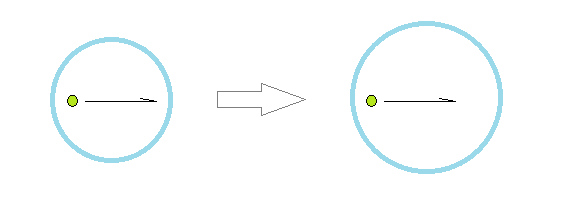Returning
to our astronaut in space, we now have an explanation for why he has
slowed down in all his actions due to the addition of neutrinos to
his environment.
Every
bit of inertial matter grew in size, so the time it takes for a
photon to cross the void inside an electron has increased. The
astronaut's time quantum has grown longer in direct proportion to the
change in size.
A
consequence of this is that the speed of light is unchanged for the
astronaut. His ruler is longer, but so is his time quantum.
Compared
to the outside observers, the astronaut has slowed down. However, the
astronaut is as oblivious to any change in time as he is to any
change in distance. To him, everything remains constant.
Having
played around with neutrinos, we continue our experiments with the
astronaut by adding zero-point photons to his space. We do this by
drenching everything including the box with a liberal supply of
photons.
What
happens now is that the photons reduce the density of neutrinos. The
photons compete with the neutrinos for space. They cannot both occupy
the same space, so the neutrinos have to leave as we turn up the
supply of photons.
The
electric force weakens as a consequence. Since photons are unaffected
by charge, they do not behave the same way as neutrinos in the
charged environment inside electrons and atomic nuclei.
Neutrinos
tend to stay inside places where walls are equally charged. Neutrinos
produce over-pressure inside electrons and atomic nuclei. This is how
they communicate the electric force. Photons don't do this. They
have no preference for being inside or outside atomic nuclei.
The
loss of electric force is therefore not compensated by the addition
of photons. Things become smaller, and time speeds up.
The
astronaut cannot detect any change in the electric force, because
it's tied up to the size of things. Likewise, there is no way for the
astronaut to detect any change in the magnetic force.
With
more photons and fewer neutrinos, the outside observers notice that
magnets in the astronaut's possession become more efficient. They
smack together faster when they attract and they move apart faster
when they repel.
However,
this too is only noticeable from the outside. The astronaut's time is
speeding up in proportion to the increase in magnetic efficiency. The
only difference that is not subject to the observers' frame of
reference is the supply of neutrinos and photons. Everything else
remains constant for the astronaut, while it changes as seen from the outside.


No comments:
Post a Comment